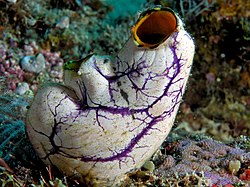| Tunicates | |
|---|---|

| |
| Gold-mouth sea squirt (Polycarpa aurata) | |
| Scientific classification | |
| Domain: | Eukaryota |
| Kingdom: | Animalia |
| Phylum: | Chordata |
| Clade: | Olfactores |
| Subphylum: | Tunicata Lamarck, 1816[4][5] |
| Classes and unplaced genera[4][7] | |
| |
| Synonyms | |
|
Urochordata Lankester, 1877 | |
A tunicate is an exclusively marine invertebrate animal, a member of the subphylum Tunicata (/ˌtjuːnɪˈkeɪtə/ TEW-nih-KAY-tə). This grouping is part of the Chordata, a phylum which includes all animals with dorsal nerve cords and notochords (including vertebrates). The subphylum was at one time called Urochordata, and the term urochordates is still sometimes used for these animals.
Despite their simple appearance and very different adult form, their close relationship to the vertebrates is certain. Both groups are chordates, as evidenced by the fact that during their mobile larval stage, tunicates possess a notochord, a hollow dorsal nerve cord, Pharyngeal slits, post-anal tail, and an endostyle. They resemble a tadpole.
Tunicates are the only chordates that have lost their myomeric segmentation, with the possible exception of the seriation of the gill slits.[8][9] However, doliolids still display segmentation of the muscle bands.[10]
Some tunicates live as solitary individuals, but others replicate by budding and become colonies,[11] each unit being known as a zooid. They are marine filter feeders with a water-filled, sac-like body structure and two tubular openings, known as siphons, through which they draw in and expel water. During their respiration and feeding, they take in water through the incurrent (or inhalant) siphon and expel the filtered water through the excurrent (or exhalant) siphon. Adult ascidian tunicates are sessile, immobile and permanently attached to rocks or other hard surfaces on the ocean floor. Thaliaceans (pyrosomes, doliolids, and salps) and larvaceans on the other hand, swim in the pelagic zone of the sea as adults.
Various species of ascidians, the most well-known class of tunicates, are commonly known as sea squirts, sea pork, sea livers, or sea tulips.
The earliest probable species of tunicate appears in the fossil record in the early Cambrian period.
Their name derives from their unique outer covering or "tunic", which is formed from proteins and carbohydrates, and acts as an exoskeleton. In some species, it is thin, translucent, and gelatinous, while in others it is thick, tough, and stiff.
- ^ Yang, Chuan; Li, Xian-Hua; Zhu, Maoyan; Condon, Daniel J.; Chen, Junyuan (2018). "Geochronological constraint on the Cambrian Chengjiang biota, South China" (PDF). Journal of the Geological Society. 175 (4): 659–666. Bibcode:2018JGSoc.175..659Y. doi:10.1144/jgs2017-103. ISSN 0016-7649. S2CID 135091168.
- ^ Fedonkin, M. A.; Vickers-Rich, P.; Swalla, B. J.; Trusler, P.; Hall, M. (2012). "A new metazoan from the Vendian of the White Sea, Russia, with possible affinities to the ascidians". Paleontological Journal. 46 (1): 1–11. Bibcode:2012PalJ...46....1F. doi:10.1134/S0031030112010042. S2CID 128415270.
- ^ Martyshyn, Andrej; Uchman, Alfred (1 December 2021). "New Ediacaran fossils from the Ukraine, some with a putative tunicate relationship". PalZ. 95 (4): 623–639. Bibcode:2021PalZ...95..623M. doi:10.1007/s12542-021-00596-1. ISSN 1867-6812. S2CID 244957825.
- ^ a b Sanamyan, Karen (2013). "Tunicata". WoRMS. World Register of Marine Species. Retrieved 4 April 2013.
- ^ Nielsen, C. (2012). "The authorship of higher chordate taxa". Zoologica Scripta. 41 (4): 435–436. doi:10.1111/j.1463-6409.2012.00536.x. S2CID 83266247.
- ^ Giribet, Gonzalo (27 April 2018). "Phylogenomics resolves the evolutionary chronicle of our squirting closest relatives". BMC Biology. 16 (1): 49. doi:10.1186/s12915-018-0517-4. ISSN 1741-7007. PMC 5924484. PMID 29703197.
- ^ Cite error: The named reference
Tatianwas invoked but never defined (see the help page). - ^ Onai T (2018). "The evolutionary origin of chordate segmentation: revisiting the enterocoel theory". Theory Biosci. 137 (1): 1–16. doi:10.1007/s12064-018-0260-y. PMID 29488055. S2CID 3553695.
- ^ Gee, H. (27 July 2007). Before the Backbone: Views on the origin of the vertebrates. Springer Science & Business Media. ISBN 9780585252728 – via Google Books.
- ^ Bone, Q., and K. P. Ryan (1974). "On the Structure and Innervation of the Muscle Bands of Doliolum (Tunicata: Cyclomyaria)". Proceedings of the Royal Society of London. Series B, Biological Sciences. 187 (1088): 315–327. Bibcode:1974RSPSB.187..315B. doi:10.1098/rspb.1974.0077. JSTOR 76405. PMID 4154453. S2CID 20806327. Retrieved 13 May 2023.
{{cite journal}}: CS1 maint: multiple names: authors list (link) - ^ Alié, Alexandre; Hiebert, Laurel S.; Scelzo, Marta; Tiozzo, Stefano (19 March 2020). "The eventful history of nonembryonic development in tunicates". Journal of Experimental Zoology Part B: Molecular and Developmental Evolution. 336 (3): 250–266. Bibcode:2021JEZB..336..250A. doi:10.1002/jez.b.22940. PMID 32190983. S2CID 213181394.